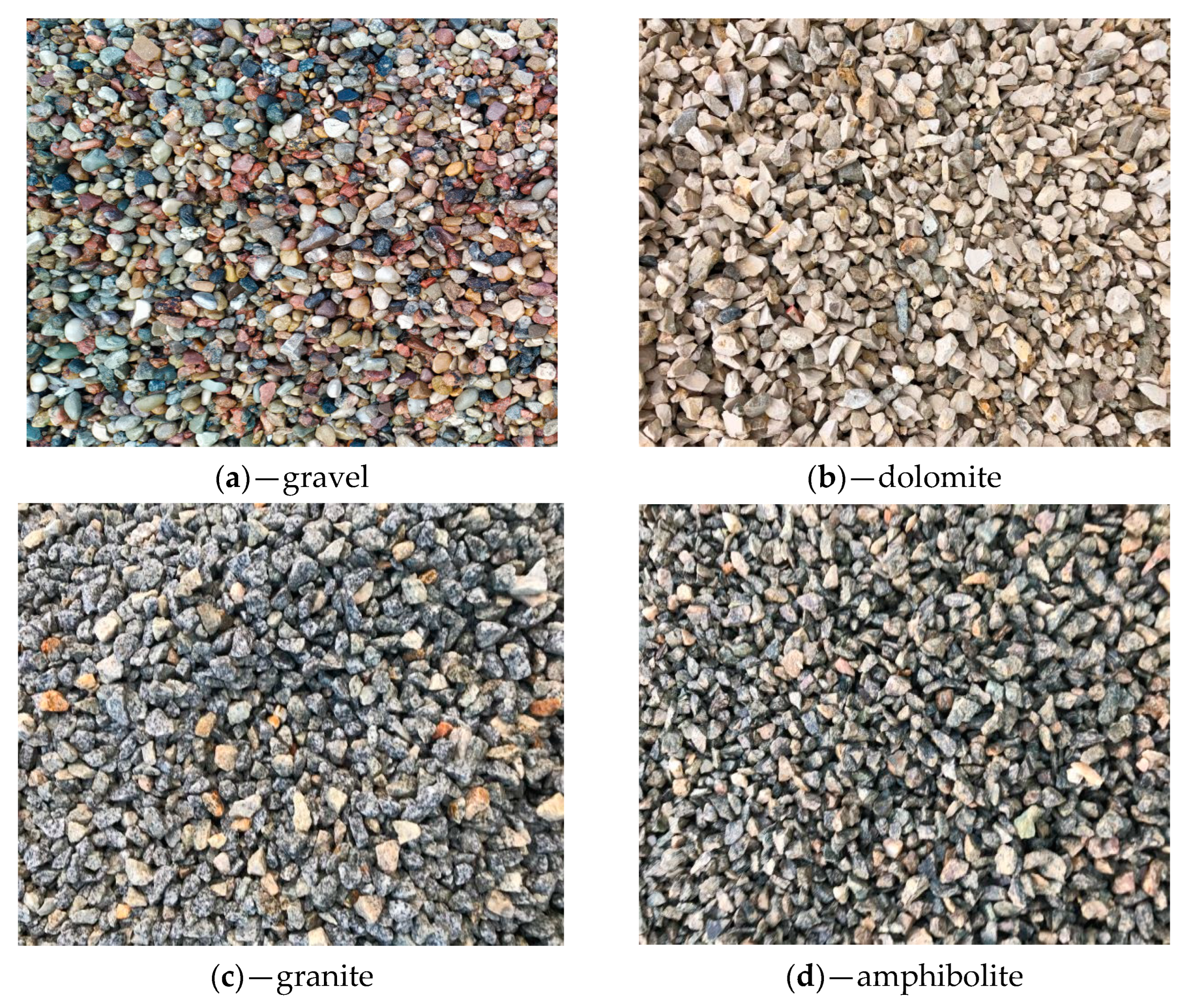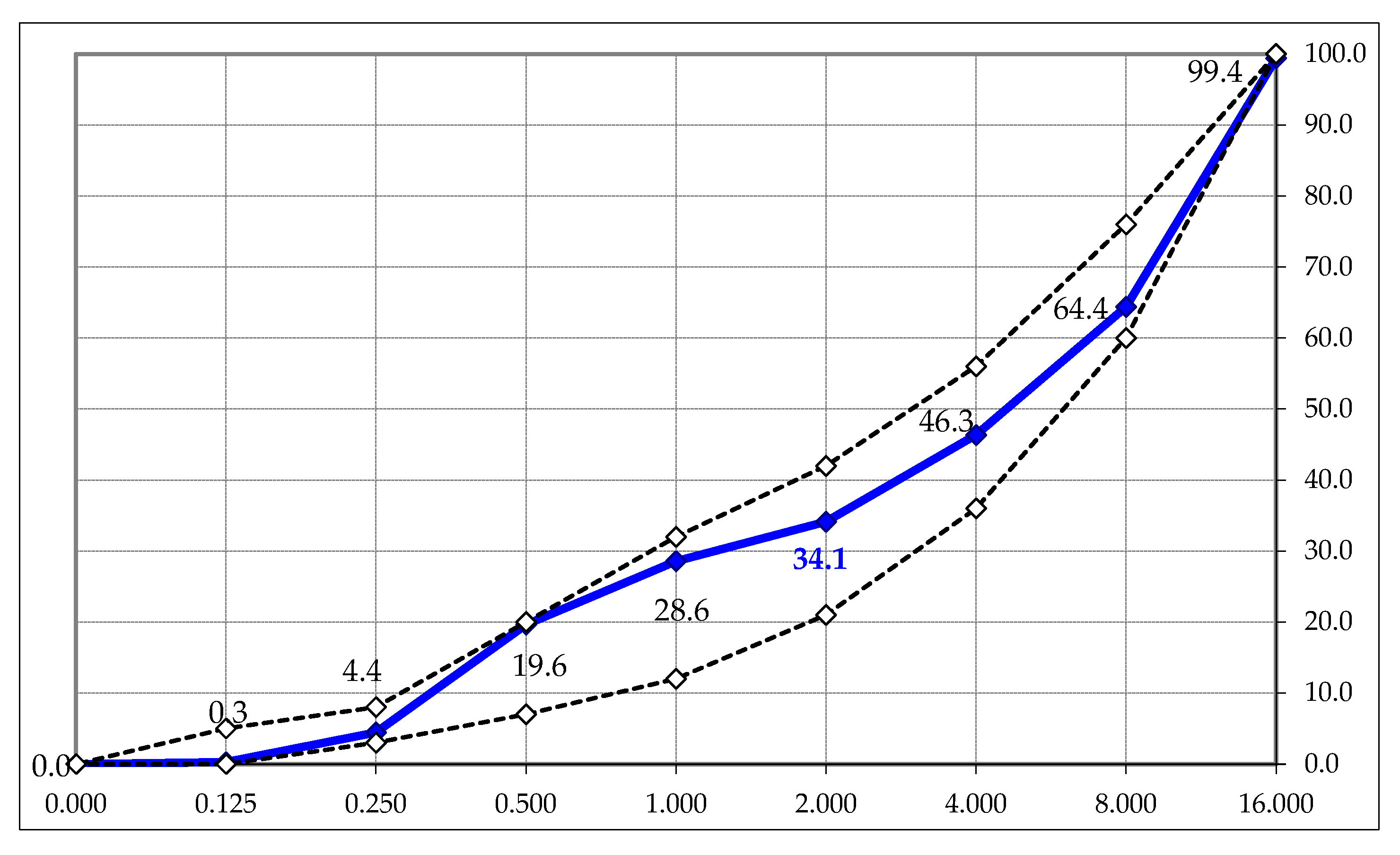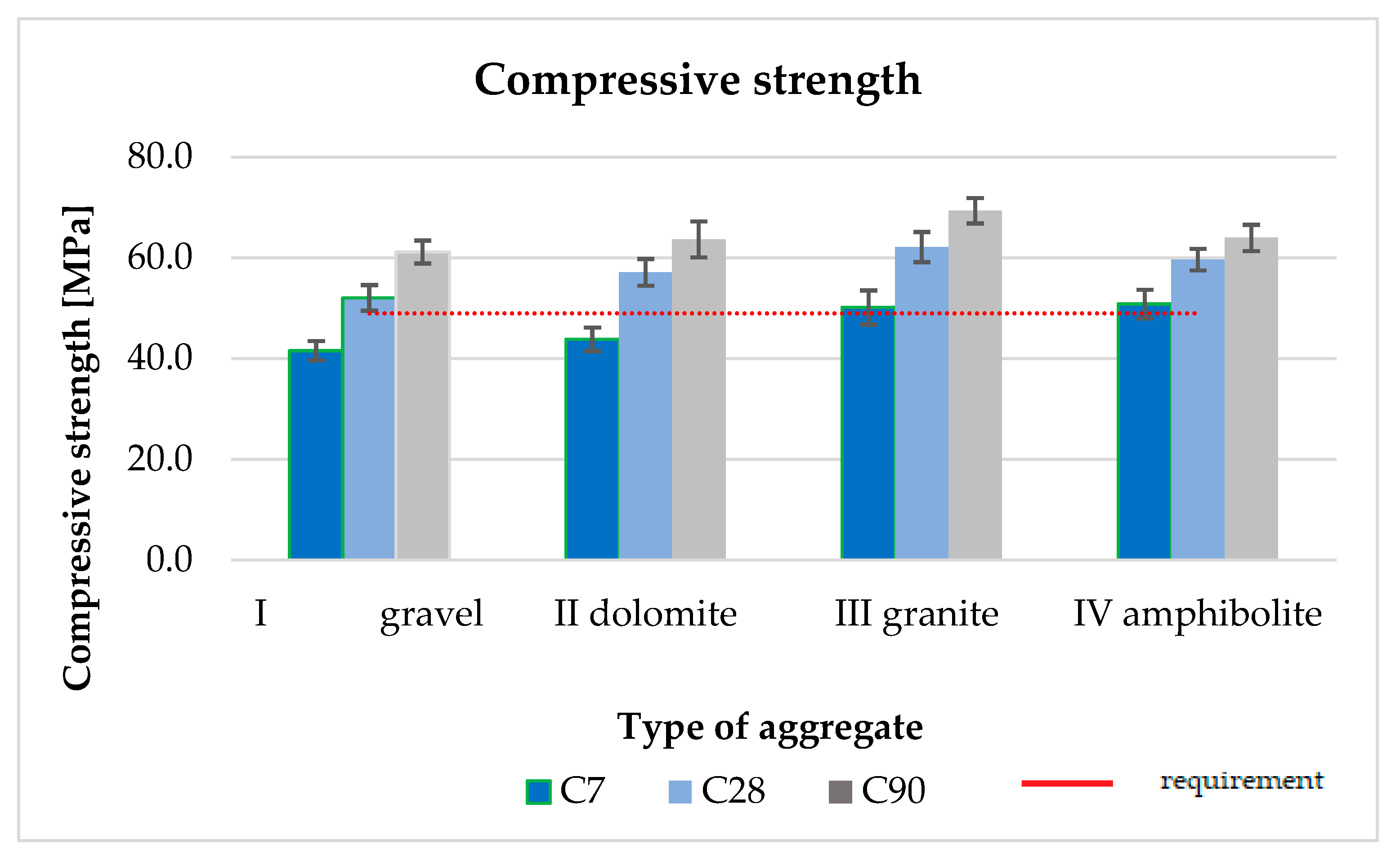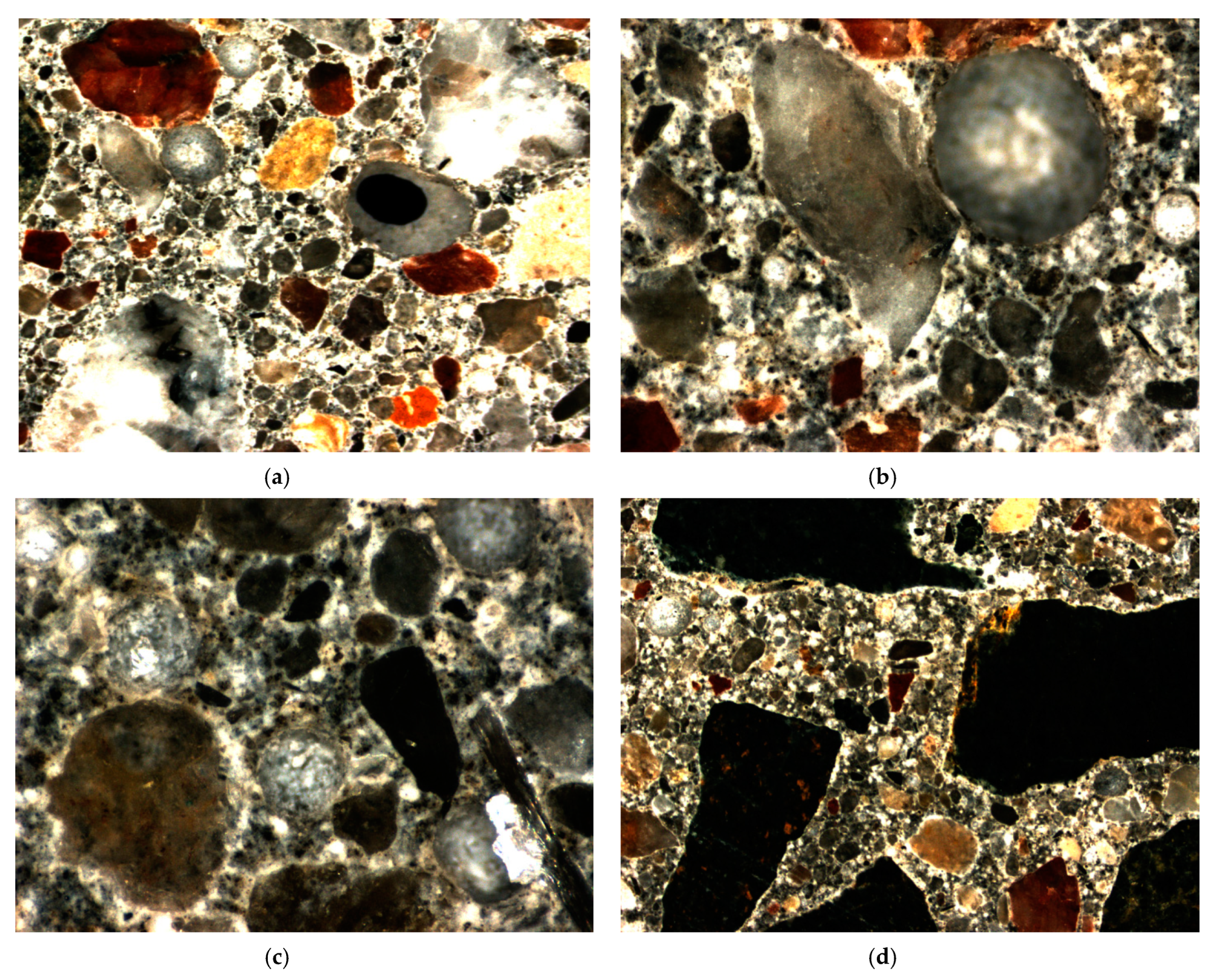The Impact of the Aggregate Used on the Possibility of Reducing the Carbon Footprint in Pavement Concrete
Abstract
1. Introduction
2. Materials and Methods
2.1. Materials
2.2. Determination of the Petrographic Composition of the Tested Aggregates in Accordance with EN 932-3:1999/A1: 2004
2.3. Methods
3. Results
3.1. Assessment of Concrete Mix Properties
3.2. Compressive Strength
3.3. Flexural Strength
3.4. Tensile Strength
3.5. Frost Resistance after 150 Cycles
3.6. Air Void Analysis
3.7. Determination of Resistance to Freezing and Thawing in the Presence of De-Icing Salts
3.8. Carbon Footprint
4. Discussion
5. Conclusions
- Four types of aggregate were used in the work (gravel, dolomite, granite, and amphibolite). The results of the compressive, bending, and splitting strength tests meet the requirements for the road surface made of cement concrete.
- In terms of durability tests, i.e., resistance to frost, analysis of the aeration structure and resistance to de-icing salts, only gravel failed to pass the salt test. The remaining concrete mixes achieved the required parameters.
- The highest compressive strength results were obtained for granite aggregate, at 69.4 MPa, and the highest bending parameters were obtained for concrete with dolomite aggregate, at 7.2 MPa.
- By analyzing the individual properties of the concrete mix, it can be concluded that the dolomite aggregate concrete mix has the best rheological properties, both 5 and 60 min after mixing the components.
- The use of CEM III cement instead of CEM I reduces the carbon footprint by 32%, and if we use locally available dolomite aggregate, we can reduce the carbon footprint by another 19%, thus including pavement concrete among environmentally friendly materials.
- The obtained values of resistance to freeze–thaw in the presence of de-icing salts meet the requirements of category FT2 for freeze–thaw, which is specified in the standards. One condition was not met for concrete with gravel aggregate.
Funding
Institutional Review Board Statement
Informed Consent Statement
Data Availability Statement
Conflicts of Interest
References
- Latawiec, R.; Woyciechowski, P.; Kowalski, K.J. Sustainable Concrete Performance—CO2-Emission. Environments 2018, 5, 27. [Google Scholar] [CrossRef]
- European Ready Mixed Concrete Organization (ERMCO). ERMCO Statistics 2015. Available online: www.ermco.eu/document/ermco-statistics-2015-final-pdf/ (accessed on 1 December 2017).
- Czarnecki, L.; Woyciechowski, P. Model of concrete carbonation as limited process—Experimental investigations of fluidal ash concrete. In Brittle Matrix Composites; Brandt, A.M., Olek, J., Glinicki, M.A., Leung, C.K.Y., Eds.; Woodhead Publishing Ltd.: Cambridge, UK, 2009; Volume 9, pp. 183–194. [Google Scholar]
- Kim, T.; Chae, C. Evaluation analysis of the CO2 emission and absorption life cycle for precast concrete in Korea. Sustainability 2016, 8, 663. [Google Scholar] [CrossRef]
- Kashef-Haghighi, S.; Shao, Y.; Ghoshal, S. Mathematical modeling of CO2 uptake by concrete during accelerated carbonation curing. Cem. Concr. Res. 2015, 67, 1–10. [Google Scholar] [CrossRef]
- Turner, L.K.; Collins, F.G. Carbon dioxide equivalent (CO2-e) emissions: A comparison between geopolymer and OPC cement concrete. Constr. Build. Mater. 2013, 43, 125–130. [Google Scholar] [CrossRef]
- Sjunnesson, J. Life Cycle Assessment of Concrete; Lund University: Lund, Sweden, 2005. [Google Scholar]
- Mohammadi, J.; South, W. Life cycle assessment (LCA) of benchmark concrete products in Australia. Int. J. Life Cycle Assess. 2017, 22, 1588–1608. [Google Scholar] [CrossRef]
- Załegowski, K.; Jackiewicz-Rek, W.; Garbacz, A.; Courard, L. Carbon footprint of concrete. Mater. Bud. 2013, 12, 34–36. (In Polish) [Google Scholar]
- Woyciechowski, P. Influence of mineral additives on concrete carbonation. In Brittle Matrix Composites 10; Brandt, A.M., Olek, J., Glinicki, M.A., Leung, C.K.Y., Eds.; Woodhead Publishing Ltd.: Cambridge, UK, 2012; pp. 115–124. [Google Scholar]
- Institute of Building Technique, Department of Heat Physics, Sanitary Installations and Environment Laboratory of Environmental Protection. Performing a Life Cycle Analysis (LCA) to Determine the Carbon Footprint for Medium Cements from the CEM I, CEM II and CEM III Groups Produced in Poland, in Accordance with PN-EN 15804: 2012 Work Number: 01929/12/ZOONF; Institute of Building Technique: Warsaw, Poland, 2012. [Google Scholar]
- Rudnicki, T. The Influence of the Type of Cement on the Properties of Surface Cement Concrete. Materials 2022, 15, 4998. [Google Scholar] [CrossRef]
- Glinicki, M.A. Inżynieria Betonowych Nawierzchni Drogowych; Wydawnictwo Naukowe PWN: Warszawa, Poland, 2019. [Google Scholar]
- Glinicki, M.A. Właściwości betonu nawierzchniowego z kruszywem odkrytym—Wpływ rodzaju cementu i pielęgnacji. Drogownictwo 2019, 4, 99–104. [Google Scholar]
- Hu, J.; Siddiqui, M.S.; Fowler, D.W.; Whitney, D. Two-Lift Concrete Paving—Case Studies and Reviews from Sustainability, Cost Effectiveness and Construction Perspectives. In Proceedings of the TRB 2014 Annual Meeting, Washington, DC, USA, 12 January 2014; IEEE: Piscataway, NJ, USA. 15p. [Google Scholar]
- Pranav, S.; Aggarwal, S.; Yang, E.H.; Sarkar, A.K.; Singh, A.P.; Lahoti, M. Alternative materials for wearing course of concrete pavements: A critical review. Constr. Build. Mater. 2020, 236, 11760. [Google Scholar] [CrossRef]
- Rudnicki, T. The method of aggregate skeleton in self compacting concrete designing with segment regression. CWB 2016, 1, 10–19. [Google Scholar] [CrossRef]
- Mackiewicz, P.; Szydło, A.; Krawczyk, B. Influence of the construction technology on the texture and roughness of concrete pavements. Roads Bridges 2018, 17, 111–126. [Google Scholar] [CrossRef]
- Glinicki, M.A.; Dąbrowski, M.; Skrzypczyński, M. Influence of curing on the properties of air-entrained concrete in the upper layer of exposed aggregate pavement-modelling study. Cem. Wapno Beton 2017, 22/84, 271–281. [Google Scholar]
- Kaszuba, S. Kształtowanie Składu Trwałego Betonu Z Udziałem Cementów Wieloskładnikowych (CEM II, CEM III) Do Zastosowania W Budownictwie Drogowo-Mostowym. Ph.D. Thesis, Politechnika Śląska, Gliwice, Poland, 2019. [Google Scholar]
- Van Dam, T.; Taylor, P.; Fick, G.; Gress, D.; van Geem, M.; Lorenz, E. Sustainable Concrete Pavements: A Manual of Practice; National Concrete Pavement Technology Center, Iowa State University: Ames, IA, USA, 2011. [Google Scholar]
- Giergiczny, Z.; Glinicki, M.A.; Sokołowski, M.; Zieliński, M. Air void system and frost salt scaling of concrete containing slag blended cement. Constr. Build. Mater. 2009, 23, 2451–2456. [Google Scholar] [CrossRef]
- Shubbar, A.A.; Jafer, H.; Dulaimi, A.; Hashim, K.; Atherton, W.; Sadique, M. The development of a low carbon binder produced from the ternary blending of cement, ground granulated blast furnace slag and high calcium fly ash: An experimental and statistical approach. Constr. Build. Mater. 2018, 187, 1051–1060. [Google Scholar] [CrossRef]
- Babu, K.G.; Kumar, V.S.R. Efficiency of GGBS in concrete. Cem. Concr. Res. 2000, 30, 1031–1036. [Google Scholar] [CrossRef]
- Rudnicki, T. Functional Method of Designing Self-Compacting Concrete. Materials 2021, 14, 267. [Google Scholar] [CrossRef] [PubMed]
- Rudnicki, T.; Jurczak, R. The impact of the addition of diabase dusts on the properties of cement pavement concrete. Arch. Civ. Eng. 2022, 68, 395–411. [Google Scholar] [CrossRef]
- Tunstall, L.E.; Ley, M.T.; Scherer, G.W. Air entraining admixtures: Mechanisms, evaluations, and interactions. Cem. Concr. Res. 2021, 150, 106557. [Google Scholar] [CrossRef]
- Dziedzic, K.; Dąbrowski, M.; Antolik, A.; Glinicki, M.A. Characteristics of concrete mix air-entrainment applying the sequential pressure method. Roads Bridges 2020, 19, 107–118. [Google Scholar] [CrossRef]
- Wong, H.S.; Pappas, A.M.; Zimmerman, R.W.; Buenfeld, N.R. Effect of entrained air voids on the microstructure and mass transport properties of concrete. Cem. Concr. Res. 2011, 41, 1067–1077. [Google Scholar] [CrossRef]
- Rudnicki, T.; Jurczak, R. Recycling of a Concrete Pavement after over 80 Years in Service. Materials 2020, 13, 2262. [Google Scholar] [CrossRef]
- Szydło, A.; Mackiewicz, P.; Wardęga, R.; Krawczyk, B. Katalog Typowych Konstrukcji Nawierzchni Sztywnych; Załącznik do zarządzenia Nr 30 Generalnego Dyrektora Dróg Krajowych i Autostrad: Warszawa, Poland, 2014. [Google Scholar]
- Glinicki, M.A.; Jaskulski, R.; Dąbrowski, M. Design principles and testing of internal frost resistance of concrete for road structures-critical review. Roads Bridges 2016, 15, 21–43. [Google Scholar] [CrossRef]
- Liu, Z. Frost Deterioration in Concrete Due to Deicing Salt Exposure: Mechanism, Mitigation and Conceptual Surface Scaling Model. Ph.D. Thesis, University of Michigan, Ann Arbor, MI, USA, 2014. [Google Scholar]
- GDDKiA. Warunki Wykonania I Odbioru Robot Budowlanych D-05.03.04 V2; Nawierzchnia Z Betonu Cementowego: Warszawa, Poland, 2019.
- Catalogue of Typical Structures of Rigid Pavements. GDDKiA, Warszawa, Poland. 2014. Available online: https://www.gddkia.gov.pl/frontend/web/userfiles/articles/d/dokumenty-techniczne_8162/Dokumenty%20techniczne/KTKNS.pdf (accessed on 30 September 2020).
- Jasiczak, J.; Wdowska, A.; Rudnicki, T. Ultra-High Performance Concretes. Properties, Technology, Applications; Association of Cement Producers: Kraków, Poland, 2008. (In Polish) [Google Scholar]
- Gołaszewski, J. Domieszki Do Betonu. Efekt Działania, Ocena I Badania Efektywności, Stosowanie; Wydawnictwo Politechniki Śląskiej: Gliwice, Poland, 2016. [Google Scholar]
- Pasławski, J.; Rudnicki, T. Agile/Flexible and Lean Management in Ready-Mix concrete delivery. Arch. Civ. Eng. 2021, 67, 689–709. [Google Scholar] [CrossRef]
- Breitenbücher, R.; Youn, B.-Y. Qualitätssicherung von Waschbetonoberflächen; Berichte der Bundesanstalt für Straßenwesen. Straßenbau, Heft S 66; OPUS: Berlin, Germany, 2010. [Google Scholar]
- Giergiczny, Z.; Baran, T.; Dziuk, D.; Ostrowsk, M. The increase of concrete frost resistance by using cement with air-entraining agent. Cem. Wapno Beton 2016, 21/83, 96–105. [Google Scholar]
- Glinicki, M.A. Methods of qualitative and quantitative assessment of concrete air entrainment. Cem. Wapno Beton 2014, 19/81, 359–369. [Google Scholar]
- Rogojsz, G.; Skupski, D.; Januszewski, B. The effect of the aggregate type on the properties of pavement concrete. Bull. Mil. Univ. Technol. 2018, 67, 83–94. [Google Scholar] [CrossRef]
- Rudnicki, T.; Wołoszka, P. The use of technology whitetopping in the aspect of implementation of repairs of flexible pavements. Bull. Mil. Univ. Technol. 2016, 65, 111–135. [Google Scholar] [CrossRef]
- PN-EN 197-1:2012; Cement—Część 1: Skład, Wymagania I Kryteria Zgodności Dotyczące Cementów Powszechnego Użytku. PKN: Warsaw, Poland, 2012.
- EN 12350-6:2019; Testing Fresh Concrete. Density. Comite Europeen de Normalisation: Brussels, Belgium, 2019.
- EN 12350-7:2019; Testing Fresh Concrete. Air Content. Pressure Methods. Comite Europeen de Normalization: Brussels, Belgium, 2019.
- EN 12350-2:2019; Testing Fresh Concrete—Part 2: Vebe Consistency Testing. Comite Europeen de Normalisation: Brussels, Belgium, 2019.
- PN-B-06250:1988; Polish Standard Normal Concrete. PKN: Warsaw, Poland, 1988. (In Polish)
- EN 480-11:2008; Admixtures for Concrete, Mortar and Grout-Test Methods—Part 11: Determination of Air Void Characteristics in Hardened Concrete. Comite Europeen de Normalisation: Brussels, Belgium, 2008.
- EN 12390 PKN-CEN/TS 12390-9; Testing Hardened Concrete—Part 9: Freeze-Thaw Resistance. Comite Europeen de Normalisation: Brussels, Belgium, 2016.
- EN 12390-3:2019; Testing Hardened Concrete—Part 3: Compressive Strength of Test Specimens. Comite Europeen de Normalisation: Brussels, Belgium, 2019.
- EN 12390-5:2019; Testing Hardened Concrete—Part 5: Tensile Strength When Splitting Test Specimens. Comite Europeen de Normalisation: Brussels, Belgium, 2019.
- EN 12390-6:2019; Testing Hardened Concrete—Part 6: Bending Strength of Test Specimens. Comite Europeen de Normalisation: Brussels, Belgium, 2019.




| Property | Unit | Type of Cement |
|---|---|---|
| CEM III 42.5 HSR-NA | ||
| Water lust | % | 29.8 |
| Beginning of binding | min | 238 |
| End of binding | min | 317 |
| Consistency in volume | mm | 0.8 |
| Specific surface | cm2/g | 4466 |
| Compressive strength F2 | MPa | 14.2 |
| Compressive strength F28 | MPa | 51.5 |
| LOI | % | 2.61 |
| IR | % | 0.82 |
| SiO2 | % | 29.18 |
| Al2O3 | % | 6.17 |
| Fe2O3 | % | 1.55 |
| CaO | % | 50.54 |
| MgO | % | 4.04 |
| SO3 | % | 2.48 |
| Na2O | % | 0.33 |
| K2O | % | 0.69 |
| eqNa2O | % | 0.78 |
| Cl- | % | 0.07 |
| Properties of Pavement Concrete | Requirements | Test Method |
|---|---|---|
| Density, tolerance to the prescription | ± 3.0% | PN-EN 12390-7 |
| Compressive strength class for traffic category KR5 ÷ KR7, not lower than: | C35/45 | PN-EN 12390-3 |
| Flexural strength of concrete for traffic category KR5 ÷ KR7, not lower than: | 5.5 MPa | PN-EN 12390-5 |
| Tensile strength of concrete when splitting for traffic category KR5 ÷ KR7, not lower than: | 3.5 MPa | PN-EN 12390-6 |
Characteristics of air pores in concrete:
| ≥1.5% ≤0.200 mm | PN-EN 480-11 |
Concrete frost resistance test F150:
| 5% 20% | PN-B-06250 |
| Sieve | Screening [%] | ||||||||
|---|---|---|---|---|---|---|---|---|---|
| [mm] | Gravel 8/16 | Gravel 2/8 | Dolomite 8/16 | Dolomite 2/8 | Granite 8/16 | Granite 2/8 | Amphibolite 8/16 | Amphibolite 2/8 | Sand 0/2 |
| 16.000 | 1.7 | 0.0 | 1.6 | 0.0 | 1.7 | 0.0 | 2.4 | 0.0 | 0.0 |
| 8.000 | 96.3 | 1.2 | 94.4 | 1.4 | 96.3 | 1.2 | 90.6 | 2.2 | 0.0 |
| 4.000 | 2.0 | 59.7 | 4.0 | 60.1 | 2.0 | 59.7 | 7.0 | 55.6 | 0.0 |
| 2.000 | 0.0 | 39.1 | 0.0 | 38.5 | 0.0 | 39.1 | 0.0 | 42.2 | 2.5 |
| 1.000 | 0.0 | 0.0 | 0.0 | 0.0 | 0.0 | 0.0 | 0.0 | 0.0 | 15.9 |
| 0.500 | 0.0 | 0.0 | 0.0 | 0.0 | 0.0 | 0.0 | 0.0 | 0.0 | 25.5 |
| 0.250 | 0.0 | 0.0 | 0.0 | 0.0 | 0.0 | 0.0 | 0.0 | 0.0 | 43.4 |
| 0.125 | 0.0 | 0.0 | 0.0 | 0.0 | 0.0 | 0.0 | 0.0 | 0.0 | 11.9 |
| 0.000 | 0.0 | 0.0 | 0.0 | 0.0 | 0.0 | 0.0 | 0.0 | 0.0 | 0.8 |
| sum: | 100.0 | 100.0 | 100.0 | 100.0 | 100.0 | 100.0 | 100.0 | 100.0 | 100.0 |
| Materials | Concrete Mix Compositions [kg/m3] | |||
|---|---|---|---|---|
| A_I | A_II | A_III | A_IV | |
| CEM III 42.5 HSR-NA | 380 | 380 | 380 | 380 |
| Water | 152 | 152 | 152 | 152 |
| Sand 0/2 | 665 | 683 | 668 | 716 |
| Gravel 2/8 | 551 | - | - | - |
| Gravel 8/16 | 684 | - | - | - |
| Dolomite 2/8 | - | 566 | - | - |
| Dolomite 8/16 | - | 703 | - | - |
| Granite 2/8 | - | - | 554 | - |
| Granite 8/16 | - | - | 687 | - |
| Amphibolite 2/8 | - | - | - | 593 |
| Amphibolite 8/16 | - | - | - | 736 |
| SP PC | 3.0 | 3.0 | 3.0 | 3.0 |
| LPA | 0.75 | 0.75 | 0.75 | 0.75 |
| Density | 2436.6 | 2487.6 | 2445.9 | 2580.9 |
| Property | Properties of Concrete Mixtures | ||||
|---|---|---|---|---|---|
| A_I | A_II | A_III | A_IV | Requirements | |
| Air content after 5 min, % | 6.3 | 6.2 | 5.7 | 5.8 | |
| Air content after 60 min, % | 5.5 | 5.9 | 5.0 | 5.2 | 4.5 ÷ 6.0 |
| Consistency after 5 min, s | 9 | 10 | 6 | 9 | |
| Consistency after 60 min, s | 14 | 13 | 12 | 14 | V2 (11÷20 s) |
| Density, g/cm3 | 2.437 | 2.488 | 2.446 | 2.581 | ±3.0% |
| Materials | Compressive Strength [MPa] | ||||
|---|---|---|---|---|---|
| A_I | A_II | A_III | A_IV | Requirements | |
| Compressive strength after 7 days | 41.6 ± 1.9 | 43.8 ± 2.4 | 50.2 ± 3.4 | 50.8 ± 2.8 | C35/45 |
| Compressive strength after 28 days | 52.1 ± 2.5 | 57.1 ± 2.6 | 62.2 ± 3.0 | 59.7 ± 2.2 | |
| Compressive strength after 90 days | 61.2 ± 2.3 | 63.7 ± 3.6 | 69.4 ± 2.5 | 64.0 ± 2.6 | |
| Density, g/cm3 | 2.440 | 2.482 | 2.446 | 2.579 | ±3.0% |
| Materials | Flexural Strength [MPa] | ||||
|---|---|---|---|---|---|
| A_I | A_II | A_III | A_IV | Requirements | |
| Flexural strength after 28 days | 5.7 ± 0.15 | 6.6 ± 0.28 | 6.1 ± 0.51 | 6.5 ± 0.29 | |
| Flexural strength after 90 days | 6.4 ± 0.17 | 7.2 ± 0.35 | 6.7 ± 0.30 | 6.9 ± 0.41 | >5.5 |
| Materials | Tensile Splitting Strength of the Test Specimens [MPa] | ||||
|---|---|---|---|---|---|
| A_I | A_II | A_III | A_IV | Requirements | |
| Concrete tensile splitting strength of the test specimens after 28 days | 3.6 ± 0.3 | 3.9 ± 0.2 | 3.5 ± 0.46 | 3.9 ± 0.27 | >3.5 |
| Concrete tensile splitting strength of the test specimens after 90 days | 4.0 ± 0.4 | 4.9 ± 0.25 | 4.3 ± 0.44 | 4.8 ± 0.31 | |
| Frost Resistance Test F150 | Type of Mixture | ||||
|---|---|---|---|---|---|
| A_I | A_II | A_III | A_IV | Requirements | |
| Mean decrease in the strength of specimens ΔR, % | 17.4 ± 1.1 | 5.4 ± 0.7 | 9.0 ± 1.2 | 1.7 ± 1.4 | <20 |
| Weight loss of samples ΔG, % | 0.05 | 0.02 | 0.03 | 0.01 | <5.0 |
| Visual assessment of samples | no cracks | no cracks | no cracks | no cracks | no cracks |
| Parameter | Type of Mixture | ||||
|---|---|---|---|---|---|
| A_I | A_II | A_III | A_IV | Requirements | |
| Total air content, A % | 4.55 | 5.60 | 4.30 | 5.21 | |
| Spacing factor, L mm | 0.19 | 0.08 | 0.14 | 0.12 | <0.20 |
| Micro air-void content, A300 % | 2.09 | 3.45 | 2.80 | 3.20 | >1.50 |
| Specific surface of the air mm−1 | 44.5 | 57.0 | 50.9 | 54.2 | |
| Total traverse length, mm | 2646 | 2646 | 2646 | 2646 | |
| No. | Mass Loss (kg/m2) | Degree of Defect | ||
|---|---|---|---|---|
| after 28 Cycles | after 56 Cycles | m56/m28 | Requirements | |
| A_I | 0.44 | 0.91 | 2.07 | <2.0 |
| A_II | 0.12 | 0.17 | 1.41 | <2.0 |
| A_III | 0.24 | 0.31 | 1.29 | <2.0 |
| A_IV | 0.09 | 0.10 | 1.11 | <2.0 |
| Parameter | Unit | C35/45_I | C35/45_II | C35/45_III |
|---|---|---|---|---|
| Carbon footprint cement | CO2/kg | 0.875 | 0.715 | 0.578 |
| Cement transportation | CO2/km/t | 0.166 | 0.166 | 0.166 |
| Carbon footprint granite aggregate | CO2/kg | 0.007 | 0.007 | 0.007 |
| Aggregate transport | CO2/km/t | 0.166 | 0.166 | 0.166 |
| Carbon footprint of concrete in cubic meters | CO2/m3 | 382 | 324 | 275 |
| Parameter | Unit | A_I | A_II | A_III | A_IV |
|---|---|---|---|---|---|
| Carbon footprint of cement CEM III 42.5 HSR-NA | CO2/kg | 0.578 | 0.578 | 0.578 | 0.578 |
| Carbon footprint of cement, 380 kg/m3 | 219.64 | 219.64 | 219.64 | 219.64 | |
| Cement transport | CO2/km/t | 0.166 | 0.166 | 0.166 | 0.166 |
| Cement transport, 100 km | 16.6 | 16.6 | 16.6 | 16.6 | |
| Carbon footprint aggregate | CO2/kg | 0.007 | 0.007 | 0.007 | 0.007 |
| Aggregate transport | CO2/km/t | 0.166 | 0.166 | 0.166 | 0.166 |
| Carbon footprint of gravel aggregate, 1235 kg/m3 | 8.65 | ||||
| Aggregate transport of gravel, 150 km | 24.9 | ||||
| Carbon footprint of dolomite aggregate, 1269 kg/m3 | 8.88 | ||||
| Aggregate transport of dolomite, 80 km | 13.28 | ||||
| Carbon footprint of granite aggregate, 1241 kg/m3 | 8.69 | ||||
| Aggregate transport of granite, 300 km | 48.8 | ||||
| Carbon footprint of amphibolite aggregate, 1329 kg/m3 | 9.30 | ||||
| Aggregate transport of dolomite, 450 km | 74.7 | ||||
| Carbon footprint of concrete in cubic meters | CO2/m3 | 269.8 | 258.4 | 293.7 | 320.2 |
Publisher’s Note: MDPI stays neutral with regard to jurisdictional claims in published maps and institutional affiliations. |
© 2022 by the author. Licensee MDPI, Basel, Switzerland. This article is an open access article distributed under the terms and conditions of the Creative Commons Attribution (CC BY) license (https://creativecommons.org/licenses/by/4.0/).
Share and Cite
Rudnicki, T. The Impact of the Aggregate Used on the Possibility of Reducing the Carbon Footprint in Pavement Concrete. Sustainability 2022, 14, 16478. https://doi.org/10.3390/su142416478
Rudnicki T. The Impact of the Aggregate Used on the Possibility of Reducing the Carbon Footprint in Pavement Concrete. Sustainability. 2022; 14(24):16478. https://doi.org/10.3390/su142416478
Chicago/Turabian StyleRudnicki, Tomasz. 2022. "The Impact of the Aggregate Used on the Possibility of Reducing the Carbon Footprint in Pavement Concrete" Sustainability 14, no. 24: 16478. https://doi.org/10.3390/su142416478
APA StyleRudnicki, T. (2022). The Impact of the Aggregate Used on the Possibility of Reducing the Carbon Footprint in Pavement Concrete. Sustainability, 14(24), 16478. https://doi.org/10.3390/su142416478





